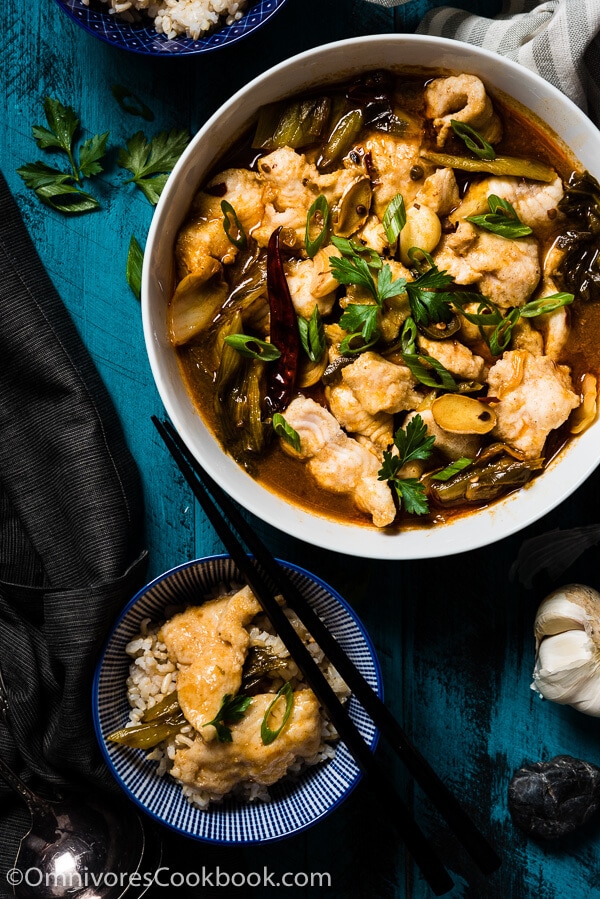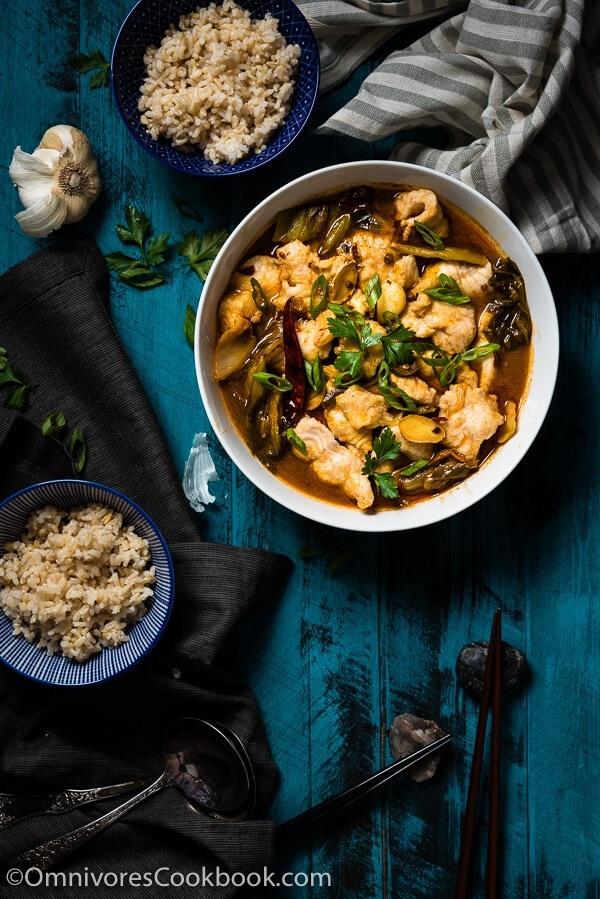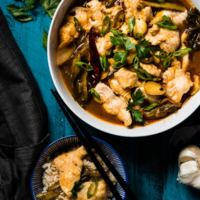
Suan Cai Yu is a lesser known Sichuan dish that features a hot and sour broth with super tender fish slices. This post includes two versions of the recipe – an easy one that you can finish cooking in 40 minutes; and an authentic one that you’ll want to use when hosting a dinner party.
Suan Cai Yu (酸菜鱼) can be translated as “hot and sour fish with pickled mustard greens”. The fish is thinly sliced and poached in a rich broth made from chicken stock, fish stock, and Sichuan pickles. The fish has a velvety and silky texture, with a piquant and zesty taste. It is a great dinner dish that you will find really comforting and satisfying on a chilly day.
This fish dish is less well-known outside of China compared to other Szechuan dishes. In fact, even in Chinese restaurants, it’s often overshadowed by its sister dish – the numbingly spicy “water boiled fish” (水煮鱼), or poached fish served in a hot oil broth.
The other day, a friend of mine, who had just returned to the US from China, requested this dish. He had just rediscovered it in China and was quite addicted to its flavor. So we decided to have a dinner party and try to develop a recipe to recreate the authentic flavor of the Chinese sauerkraut fish.
Long story short, the dinner party was super successful.
We got a live 5-pound catfish and some Sichuan pickles from our local Asian market.
The cooking process is very similar to that for Sichuan poached beef, which I had cooked a while previously, so everything went very smoothly. Plus, I happened to have just cooked cook this super creamy chicken stock and used it as the soup base. The broth turned out SO GOOD that we could not stop sipping it.

I did come across a small problem. Due to a slight miscommunication, our fish handler only briefly cleaned our fish instead of filleting it. I ended up having to fillet a fish as big as a monster. Because catfish meat is quite dense and springy, it took me a while to finish the job and I ended up with a bloody finger. If you’re trying to fillet a fish at home, be sure to wear knife-proof gloves while working (I got them immediately after cutting my finger). They’re lightweight and fit your hands snugly, so you won’t feel encumbered.
After our dinner party, I developed an easier recipe by using pre-cut catfish fillets. If you don’t feel like dealing with a whole fish, you can use this version instead. Compared to the authentic version, I admit, the easy version does not 100% recreate the super rich broth. However, it saves lots of extra procedure and will let you finish the dish in 40 minutes. It’s simple enough that you’ll feel comfortable cooking it for a weekday dinner.
On the other hand, if you have extra time and want to serve a big crowd, definitely try the authentic version. The cooking process is almost the same. All you need to do is find a big live fish and a deep skillet large enough to cook it. If possible, use homemade stock. You’ll create a super comforting dish – like a warm bowl of hot and sour soup, only ten times more scrumptious.
Cooking notes
- You can use other types of fish, such as tilapia, but I personally always choose catfish over others, due to its fattier texture.
- To save prep time, get catfish nuggets instead of fillets.
- Make sure to use the proper type of pickle to recreate the most authentic flavor. You should able to find the pickles at any large Asian market.
- At the end of cooking, you’ll need to create an herb-infused hot oil and pour it over the fish. It’s a Chinese cooking technique called ming you (明油). It makes the dish look better and adds great flavor to the broth. This step is very important in this dish. It adds a few calories but makes a big difference in flavor.
I hope you enjoy!

Do you like my recipes? Sign up for Omnivore’s Cookbook’s weekly newsletter to get the latest updates delivered to your inbox and a free e-cookbook! And stay connected via Facebook, Instagram, Pinterest and Google+. Thanks for reading and happy cooking!

Suan Cai Yu (Easy Version)
Ingredients
Marinade
- 1 pound (400 grams) catfish fillets (or catfish nuggets)
- 1 egg white
- 1/4 teaspoon white pepper
- 1/8 teaspoon salt
- 1 tablespoon potato starch
Cook
- 2 chili peppers , dried
- 3 green onions , chopped
- 6 cloves of garlic , halved
- 1 slice ginger
- 2 tablespoons doubanjiang (or 1 tablespoon for a less spicy dish)
- 1 pack (250 grams / 9 oz.) Sichuan pickled mustard greens , sliced
- 1/4 cup pickled jalapeno for extra sourness (Optional)
- 1 tablespoon Shaoxing wine
- 3 to 4 cups chicken stock
- 2 teaspoons sugar
- 1/2 teaspoon salt or to taste (or 1/4 teaspoon fish sauce)
- 1/4 teaspoon white pepper powder
Oil
- 2 tablespoons peanut oil
- 1 teaspoon Sichuan peppercorn
- 1 tablespoon doubanjiang
Instructions
To marinate the fish
- To slice catfish, tilt the knife so it’s 45 degrees against the cutting board. Slice fish in a sawing motion along the grain into 1/2 cm (1/4 inch) thick slices.
- Combine fish, white pepper, salt, egg white, and potato starch in a bowl. Gently mix the ingredients by hand, until the fish is evenly coated with a thin layer of starch. Let marinate for 10 to 20 minutes.
To cook the fish
- Heat vegetable oil in a deep skillet (or a wok) over medium heat until warm. Add green onion, garlic, ginger, and chili pepper. When it starts to sizzle, turn to medium low heat. Cook for 1 to 2 minutes.
- Add doubanjiang. Stir and cook until the herbs are evenly coated.
- Add Sichuan pickles and jalapenos (if using). Cook and stir for 5 minutes. Add Shaoxing wine to deglaze the pan. Quickly stir a few times.
- Add chicken stock. Cook over medium heat until boiling. Turn to medium low heat and let the broth simmer for 5 minutes. Transfer the pickles to a big serving bowl.
- Make sure there is at least 1 cm (1/2 inch) of broth in the skillet, so the fish slices will be submerged later. Add more chicken stock if necessary, and return to a boil.
- Add sugar, salt, and white pepper powder. Mix well. Taste the broth and adjust seasoning if needed. The broth should be slightly salty.
- Turn to medium heat. Add fish slices in two batches. Use a spatula to gently transfer the fish to the skillet, and use a pair of tongs to quickly separate the slices without tearing the fish apart. Cook until fish is just cooked through, less than 30 seconds. Transfer the fish and the soup to the serving bowl on top of the pickles.
To cook the oil
- Heat oil in another small skillet until warm. Add Sichuan peppercorns and doubanjiang. Cook and stir until the oil turns red and the peppercorns turn dark.
- Use a spatula (or colander) to remove and discard the solid ingredients.
- Pour the oil onto the fish while it’s hot.
- Garnish the fish with green onion and serve warm.

Suan Cai Yu (Authentic Version)
Ingredients
Marinade
- 1 (2.6 kg / 6 pound) live catfish (generate about 1 kg / 2.5 pound fillet)
- 2 egg white
- 1 teaspoon white pepper
- 1/4 teaspoon salt
- 2 tablespoons potato starch
Cook
- 4 dried chili pepper
- 1 leek , sliced
- 8 garlic , halved
- 2 slices ginger
- 2 tablespoons doubanjiang
- 400 grams Sichuan pickled mustard greens , sliced
- 1 tablespoon Shaoxing wine
- 6 cups chicken stock
- 1 teaspoon sugar
- 1/2 teaspoon salt (or to taste)
- 1/2 teaspoon white pepper powder
Oil
- 2 tablespoons peanut oil
- 1 teaspoon Sichuan peppercorn
- 1 tablespoon doubanjiang
Instructions
To marinate the fish
- Ask the fish handler to fillet your fish, and reserve the head and bones. If the fish market doesn’t have this service, fillet the fish according to this video. (Optional) To serve the fish the authentic way, you can leave the fish skin on. It’s easier to cook the fish this way, because the skin will hold the flesh together, preventing it from falling apart. On the other hand, catfish skin is pretty fatty and might taste a bit greasy after cooking. If you don’t like the mouthfeel, remove and discard the skin.
- To slice catfish, tilt the knife so it’s 45 degree against the cutting board. Slice fish in a sawing motion along the grain into 1/2 cm (1/4 inch) thick slices.
- Combine fish, white pepper, salt, egg white, and cornstarch in a bowl. Gently mix the ingredients by hand until the fish is evenly coated with a thin layer of starch. Let marinate for 10 to 20 minutes.
To cook the fish
- Heat vegetable oil in a deep skillet (or a wok) over medium heat until warm. Add green onion, garlic, ginger, and chili pepper. When it starts to sizzle, turn to medium low heat. Cook for 1 to 2 minutes.
- Add doubanjiang. Stir and cook until the herbs are evenly coated.
- Add Sichuan pickles and jalapenos (if using). Cook and stir for 7 to 8 minutes. Add Shaoxing wine to deglaze the pan. Quickly stir a few times.
- Add chicken stock. Cook over medium heat until boiling.
- Add fish head and bones. Cook until boiling. Turn to medium low heat and let the broth boil for 15 to 20 minutes.
- Use a pair of tongs to remove the fish head and bones. (Optional) The authentic Chinese dish will include these bone parts in the big serving bowl because they have fish meat on them. The meat on the head is the best part - very tender and moist. But if you don’t like this, you can discard the bones.
- Transfer all the pickles to a big serving bowl.
- Make sure there is at least 2 cm (2/3 inch) broth in the skillet, so the fish slices will be submerged later. Add more chicken stock if necessary, and return to a boil.
- Add sugar, salt, and white pepper powder, mix well. Taste the broth and adjust seasoning as needed. The broth should be slightly salty.
- Turn to medium heat. Add fish slices in small batches. Use a spatula to gently transfer the fish to the skillet, and use a pair of tongs to quickly separate the slices without tearing the fish apart. Cook until fish is just cooked through. Transfer the fish and soup to the serving bowl on top of the pickles.
To cook the oil
- Heat oil in another small skillet until warm. Add Sichuan peppercorns and doubanjiang. Cook and stir until the oil turns red and the peppercorns turn dark.
- Use a spatula (or colander) to remove and discard the solid ingredients.
- Pour the oil onto the fish while hot.
- Garnish the fish with green onion and serve warm.













Oh no hope your finger heals soon! This dish looks delicious, would love a bowl of rice to go with it!
I made recently. One of the best fish dishes I ever enjoyed! Thank you for the recipe.
I’m so glad to hear you enjoyed the dish Ola! I love this one a lot too, so flavorful 🙂
Have a great day!
With my first attempt, the broth came out waaaayyyy too salty. I’ve read that doubjiang can vary tremendously in salt content, so the current package I have is probably just too much. I also used zha cai (榨菜) instead of greens, so that probably didn’t help either.
That being said, the spiciness was excellent and the fish, when picked out, was good as well.
Hi Thos, I’m sorry to hear the dish didn’t turn out as well as you thought. Yes doubanjiang can be very salty and I’ve got other feedback on my other recipes stating similar feedback. The other chance is, if you’re using a salted cooking wine, that can make the dish very salty too. I love the diea of adding cha cai and will definitely try out next time. But yeah, you probably need to reduce the amount of doubanjiang and salt. If the dish is not spicy or fragrant enough, add some homemade chili oil will be very helpful.
I’ve gotta try this recipe. My 8-year-old boy wants to have more after eating Suan Cai Yu at a friend’s house. I tried making it with cod fillet and store bought pre-packaged Suan Cai Yu seasoning. It didn’t turn out very good. Neither of us like it. The texture and taste of cod weren’t good for making this type of dish.
Love your posts. The detailed instructions/description of the dishes make them so interesting and easy to follow while cooking. I also grew up in Beijing. Hope to see some traditional Beijing dishes in your posts. 🙂
Hi Zhen, I’m so happy to hear you decided to try out this recipe!
To make the best suan cai yu, I’d highly recommend live catfish, if you can find one. It takes a lot of effort to fillet it, but that’s the only way to get super tender thin sliced fillet that holds together. I used both fish fillet and a live catfish when testing the recipe, the one made with live fish was clearly a win. Plus, you can use the fish head and bone to make a broth, which is the practice of Chinese restaurant. The next best choice is catfish fillet or catfish nuggets. Cod and sea bass won’t work so well, because they’re too lean.
Happy cooking and hope you dish turns out great 🙂
Thank you so much for this recipe, I’ve just made it and it was *delicious*. I already can’t wait to make it again and do it true justice with fresh catfish and its bones in the broth. I actually made this with cod and it was still very (very!) good. I’m a gringo though 🙂
The only wobble I had was with the marinade. One egg white seemed abit much for my fishes and so the marinade didn’t stick to them so well, and the broth got abit murky with it when I cooked the fish. No problemo, I just strained the broth. Next time I’ll start with half an egg white, and go from there.
And I would encourage everyone to make it with the full amount of doubanjiang! Don’t worry, it’s not tooo spicy.
Cheers x
Oh and I noticed there is more sugar in the authentic recipe than in the one with fillets, not sure if that’s a mistake? I dialled the fillet recipe down to 1 tsp sugar and it was fine.
Hi Laura, so sorry to reply your message so late and thanks for taking time to write a comment. I’m glad the recipe worked out for you! Yes cod will be a great choice for the dish, but I believe you would like it even more with a fresh fish!
And thanks for the feedback about the egg! You’re totally right, you can use less egg, or you drain the marinade before adding the fish.
About the sugar, I totally forgot why I wrote down two different numbers. I did cook this dish twice, with a whole fish and fish fillets. Maybe I realized the soup is a bit too spicy and added more sugar to mellow it out. 1 tsp will totally work if the dish is not too spicy for you.
Happy cooking and hope you have a great week ahead Laura 🙂
Hi, Maggie,
Can this be made with the canned sichuan preserved vegetable or is that very different from the pickled mustard greens you list?
Brilliant recipe! I made some tweaks on the way but the basis of your recipe is amazing! Thank you so much for sharing
a gf and I made this for Lunar New year a couple years ago and it was the standout dish. Such complex deep and absolutely delicious flavors. Thank you so much for making it available to English readers!!